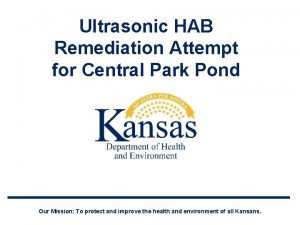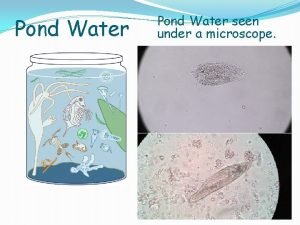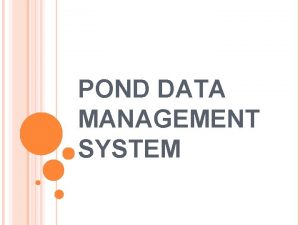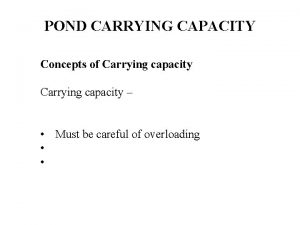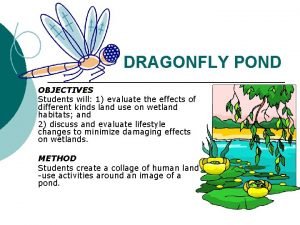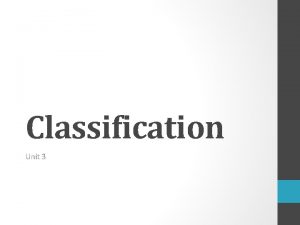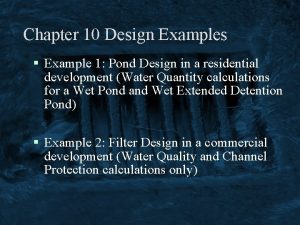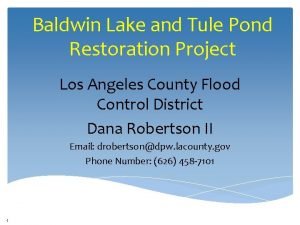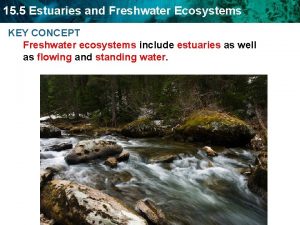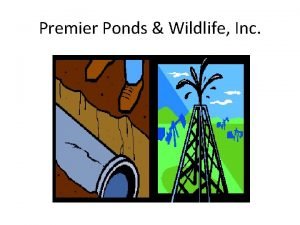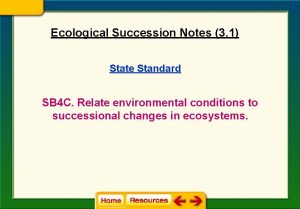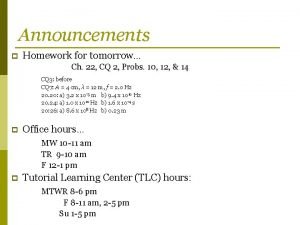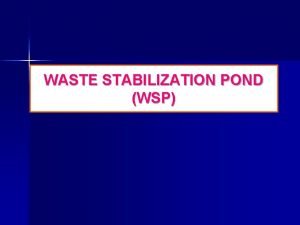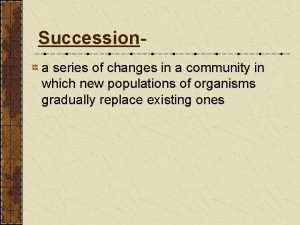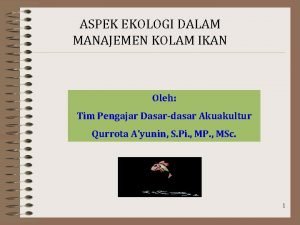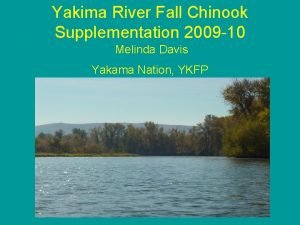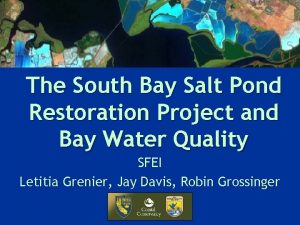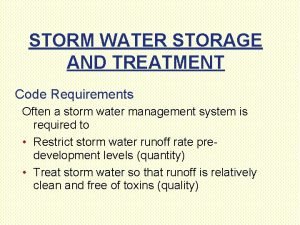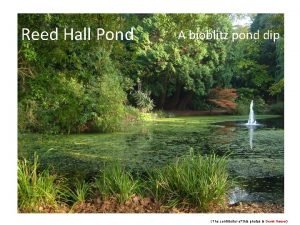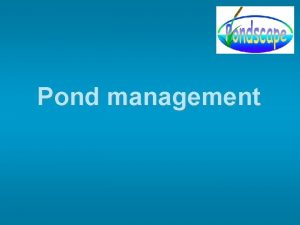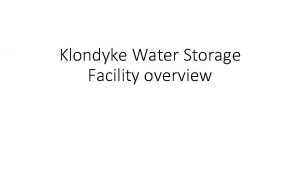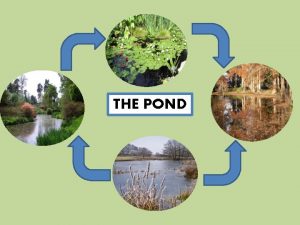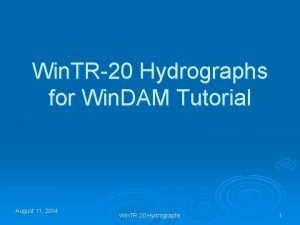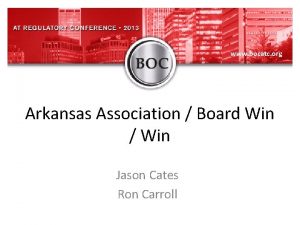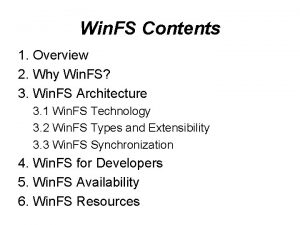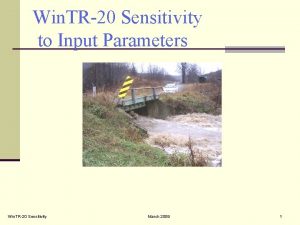Welcome to Win Pond Training History of Win









































![Design Check tab [ Use New Pipe Length ] This will return you to Design Check tab [ Use New Pipe Length ] This will return you to](https://slidetodoc.com/presentation_image/37a401a3ce9f51f675adb9e64f94910c/image-42.jpg)
















- Slides: 58

Welcome to Win. Pond Training

History of Win. Pond • 2002 – Missouri’s Pond Design program selected as model for Win. Pond by Engineering Business Area Advisory Group (EBAAG) – Development began in July (Phase I) – Alpha version released in December

History of Win. Pond • 2003 – Alpha version tested – Beta version released in June – Beta version tested – Second beta version released in December

History of Win. Pond • 2004 – Second beta version tested – Third beta version released in July – Break team formed and met in Fort Collins to begin testing on “final” version – Continued testing; communicated problems via web-based collaboration software and email.

History of Win. Pond • 2005 – Testing continued – Win. Pond 2005, Version 1. 0 released in September • 2006 – Mike Sears (from Missouri) was given task of correcting the problems found in Version 1. 0 – Several cycles of development and testing occurred – Win. Pond 2006, Version 1. 5 released in October, 2006

User’s Guide for Win. Pond my. NRCS -> Field Tools tab -> Downloads Pond Design (Win. Pond) Or at http: //directives. sc. egov. usda. gov/ User Guides -> 210 -7 -6 Win. Pond 2006 There is also a link to the user’s guide and an FAQ page on Missouri’s web site Technical Resources -> Engineering Tools and Resources -> Engineering Software-> Win. Pond Design Program

Starting Win. Pond Start -> All Programs -> Engineering Applications -> Win. Pond

Main Program Window

“File”

“File” Project data is now all stored in 1 single file instead of 5 separate ones. The single file will have a PRJ extension (e. g. , Project 123. prj ) Old projects from DOS program?

“Tools” This is basically “Change Defaults” from the DOS Program

“Help”

Tools -> Options

Tools -> Options The settings entered here are stored in a file named Win. Pond. conf in the folder c: Documents and Settings user. nameLocal Settings Application DataUSDA, NRCSWin. Pond

Tools -> Options (Aux. Spillway)

Tools -> Options (Ground)

Tools -> Options (Earthwork)

Tools -> Options (Drawdown)

Tools -> Options (Design)

Exercise Load Win. Pond and enter your own option settings.

Win. Pond window Menu Screen Tabs Input Data Info Line Tab navigation

Creating a “default” template There are some data inputs (e. g. , state, county, and designed by) that most user’s would like to come up as defaults whenever they begin a new project. This can be accomplished by creating a “default” project.

Creating a “default” template The first step is to select “File -> New”

Creating a “default” template The next step is to go through the screen tabs entering data for those fields that are fairly constant from design to design. Examples? State, county, designer; Rainfall frequencies for principal and aux. spillways; Front slope, back slope, top width;

Creating a “default” template Elevation-storage data is normally data that will change from design to design. Data on this screen is therefore not a good candidate for a default template. To leave it blank and move to the next tab you will need to click on I am making a template project.

Creating a “default” template Once you have entered all the data you want in your “default” project template, select “File -> Save As…” and save the project to default. prj in the default data path entered under Tools -> Options (for example, C: Customer_Files_Toolkit )

Exercise Create a “default” template.

Start a new project Simply select “File -> New” Data from your default project should then be loaded.

Tips on entering data Before you get started, keep these in mind: . ENTER key – preferred way to move between fields, rather than clicking with the mouse. . TAB key – can also use to move between fields but with no scrolling. Shift + TAB - moves cursor to the previous field. Delete or Backspace - use to delete characters in the input field

Project tab

Elevation-Storage tab

Elevation-Storage Curve

Hydrology tab

Runoff Curve Number Determination

Sediment tab Reduces the amount of storage available when the floodrouting is done Used to determine the minimum height for the inlet elevation

Principal Spillway tab

Conduit tab

Floodrouting When done with the Conduit tab and you press the Principal Routing tab, the floodrouting for the principal spillway occurs. An alert window will appear if there any problems.

Principal Routing tab The auxiliary elevation can be changed, but only to a larger value.

Aux Spillway tab If you want to define flow depth instead of bottom width, check this option.

Aux Routing tab The top of fill elevation can be changed, but only to a larger value.
![Design Check tab Use New Pipe Length This will return you to Design Check tab [ Use New Pipe Length ] This will return you to](https://slidetodoc.com/presentation_image/37a401a3ce9f51f675adb9e64f94910c/image-42.jpg)
Design Check tab [ Use New Pipe Length ] This will return you to Principal Routing screen to run through the calculations with the new pipe length.

Ground Profile/Cross Section tab NOTE: To change H. I. or % ground slope, double-click on Elev. Or Dist. field NOTE: Negative distances are upstream of centerline

Ground Profile view Use scroll bar to move between cross sections. Up/down arrows can also be used.

Embankment Cross Section tab

Embankment Cross Section tab

Embankment Cross Section view Use scroll bar to move between cross sections. Up/down arrows can also be used.

Ground/Embankment Intersection tab

Reports tab

Report Viewer This report can either be printed or saved to a text file.

Example report showing Job Class & Inventory Size Job Class

Viewing Principal and Auxiliary Routings On Principal Routing View, change the Trial number to view other trials (if applicable).

Viewing Principal and Auxiliary Routings Tabular Data

Saving your data Select “File -> Save” or “File -> Save As” or press F 10

Problems? • Win. Pond Version 1. 5, 2006 has fixed many of the “issues” in version 1. 0 • A Win. Pond FAQ can be found at http: //www. mo. nrcs. usda. gov/technical/engr/software/winpondfaq. html Any problems found in this new version will be placed here along with the problems that existed in version 1. 0. • If you find any problems in version 1. 5, use the link at the bottom of the FAQ page to report them.

Practice time

Review exercises Questions?

THE END • “The U. S. Department of Agriculture (USDA) prohibits discrimination in all its programs and activities on the basis of race, color, national origin, sex, religion, age, disability, political beliefs, sexual orientation, and marital or family status. (Not all prohibited bases apply to all programs. ) Persons with disabilities who require alternative means for communication of program information (Braille, large print, audiotape, etc. ) should contact USDA's TARGET Center at 202 -720 -2600 (voice and TDD). • “To file a complaint of discrimination write USDA, Director, Office of Civil Rights, Room 326 -W, Whitten Building, 14 th and Independence Avenue, SW, Washington, DC 20250 -9410 or call 202 -720 -5964 (voice or TDD). USDA is an equal opportunity provider and employer. ”
 Habit 4 think win win summary
Habit 4 think win win summary Win win win lose lose lose
Win win win lose lose lose Win-win win-lose lose-lose
Win-win win-lose lose-lose Management practices in post stocking of fish
Management practices in post stocking of fish Winpond
Winpond Expand the pie
Expand the pie Winwin hesap
Winwin hesap Think win win scenarios
Think win win scenarios What is habit 4
What is habit 4 Example of a win win situation
Example of a win win situation Win win strategies
Win win strategies Habit 4 summary
Habit 4 summary Win win nacin placanja
Win win nacin placanja Habit 4 think win win summary
Habit 4 think win win summary Welcome welcome this is our christmas story
Welcome welcome this is our christmas story Welcome to the training session
Welcome to the training session Apolonio tree nursery
Apolonio tree nursery Texel pond liner
Texel pond liner Management of rearing ponds
Management of rearing ponds Pond water under microscope
Pond water under microscope Pond water web
Pond water web Life cycle of a pond skater
Life cycle of a pond skater Pond data management system
Pond data management system Carrying capacity of pond
Carrying capacity of pond Big fish little pond effect
Big fish little pond effect Profundal zone
Profundal zone Tyre pond
Tyre pond Phil race ripples on a pond
Phil race ripples on a pond What is haiku
What is haiku Exmaples of personification
Exmaples of personification Dragonfly pond activity
Dragonfly pond activity Keep pond clean or froggy gets sick
Keep pond clean or froggy gets sick Wet pond design example
Wet pond design example How are sound waves like ripples in a pond brainpop
How are sound waves like ripples in a pond brainpop Abiotic factors in pond
Abiotic factors in pond Water restoration baldwin
Water restoration baldwin Zones of lake ecosystem
Zones of lake ecosystem Frac pond liner
Frac pond liner Ecological succession succession of a pond
Ecological succession succession of a pond Ecological succession succession of a pond
Ecological succession succession of a pond A one hectare pond is sampled in early september
A one hectare pond is sampled in early september Gainesway pond
Gainesway pond Two rocks are simultaneously dropped into a pond
Two rocks are simultaneously dropped into a pond Pond
Pond Pond succession stages
Pond succession stages Frac pond liner
Frac pond liner Sumeet has a pond in the shape of a prism
Sumeet has a pond in the shape of a prism Pond succession
Pond succession Sequence of food chain
Sequence of food chain Ecological pond
Ecological pond Billy's acclimation pond yakima county
Billy's acclimation pond yakima county South bay salt pond restoration project
South bay salt pond restoration project Pride of the pond tunica
Pride of the pond tunica Retention vs detention pond
Retention vs detention pond Bhuj solar pond
Bhuj solar pond Pond food webs
Pond food webs Water plops into pond splish-splash downhill
Water plops into pond splish-splash downhill The lickey pies
The lickey pies Life cycle of a lake
Life cycle of a lake
















